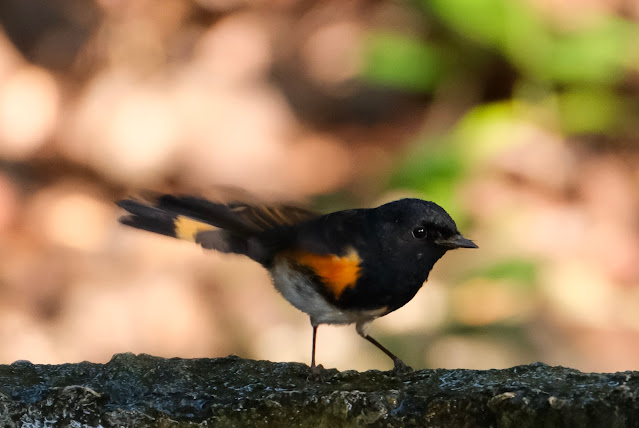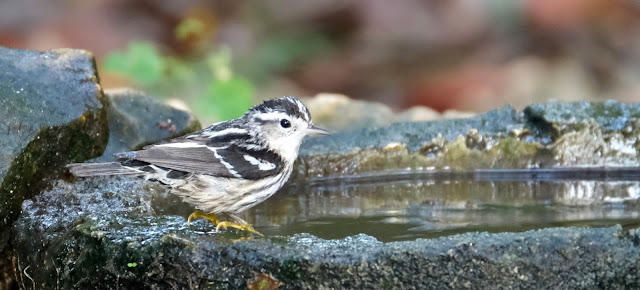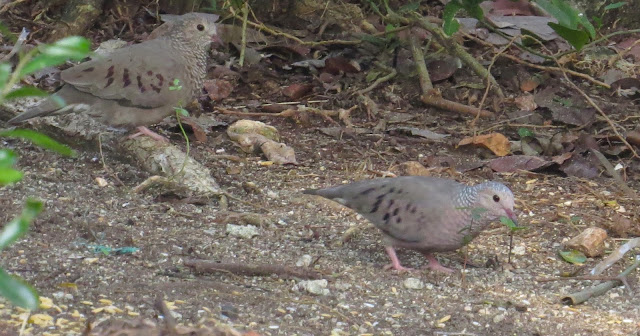28 November, 2023
Cayo Coco and Surrounding Cays
We set off early to hunt for Bahama Mockingbird (Mimus gundlachi) and Oriente Warbler (Teretistris fornsi) - Score, Bahama Mockingbird zero, Oriente Warbler, one!
It was not through lack of effort.
As the sun came up, dedicated birders were scouring the bushes, pleased to be out in the freshness of the morning, with many warblers and other species to make it all worthwhile.
A Northern Parula (Setophaga americana) is easy to find at this time of the year in Cuba, but its ubiquity renders it not one scintilla less delightful.
On every stretch of sandy shore, Beach Moonflower (Ipomoea violacea) spread its tendrils along the ground.
One of the distinct highlights of this early morning foray was the presence of a small group of Cuban Gnatcatchers (Polioptila lembeyei), an energetic and thoroughly appealing little bird. Tania's picture below displays their charm to its fullest advantage.
Karl is possessed with a keen eye and a rare ability to discover the small and the unusual. I was delighted when he pointed out a Peanut Snail to me (genus Cerion), a small air-breathing land snail.
For an entertaining and erudite discussion of this organism see Stephen Jay Gould's essay Opus 100 in The Flamingo's Smile - Reflections in Natural History (1985).
Calcareous Morning-Glory (Ipomoea microdactyla) is a spectacular flower.
On the way back to the resort, while travelling along the causeway, we espied huge flocks of flamingoes way out in the lagoons, but other mixed flocks were somewhat closer.
This group of Snowy Egrets (Egretta thula) decided to stay together.
In the shot below you may see Great Egret (Ardea alba), American White Ibis (Eudocimus albus) Roseate Spoonbill (Platalea ajaja), Tricoloured Heron (Egretta tricolor) and Neotropic Cormorant (Nannopterum brasilianum) - and that doesn't take into account the gulls, terns and frigatebirds wheeling overhead.
Lorraine, with her superior equipment, was able to bring the spoonbills in a little closer than I was.
After lunch, some decided to stay back and enjoy the beach, perhaps sipping on a pina colada or an ice cold beer under a ramada. There was lots of activity.
Some of us (Brian, Tania, Ernesto, Odey, me and, of course, Jovany) were anxious to go back to The Cave to try our luck again for Painted Bunting (Passerina ciris), an outstandingly beautiful species that is a passage migrant to Cuba, known to favour Coco Cayo. It has been seen at The Cave previously, but on this occasion it declined to show itself.
There was much of additional interest, however.
At least some of the people who declined to accompany us based their reasoning on the fierce swarms of mosquitoes encountered on our first visit. The second time around, inexplicably, there was hardly an insect in sight, and we birded in comfort without the constant hum and the noise of people slapping.
The behavioural change we encountered with the warblers familiar from home verged on extreme. This female American Redstart (Setophaga ruticilla) showed no fear of humans and at one point actually perched on my boot.
An Ovenbird (Seiurus auricapilla) is a bird not easily seen at home, and rarely outside the migratory period, whereas in Cuba it is often seen in parks and gardens.
A female Black-throated Blue Warbler (Setophaga caerulescens) joined the others at the feeder; snapping at flying insects and gleaning from the foliage.
So many species throughout the world are essentially black-and-white, but each has a distinctly different appearance from another. It is remarkable that two such basic colours can be arranged in such splendid diversity.
Not to be outdone by the warblers, a Greater Antillean Grackle (Quiscalus niger) took its turn at the bath.
This little corner of Cayo Coco is called The Cave, because there is, in fact, a cave which was formerly an underground discotheque, now a home to a large colony of two species of bat.
The following picture is quite atrocious, but it shows a Waterhouse's Leaf-nosed Bat (Macrotus waterhousii) hanging from the roof of the cave.
There were many hundreds of bats and it was a wonderful opportunity to experience my first bat cave from the inside.
Across from the resort, a Northern Mockingbird (Mimus polyglottos) occupied a bench, reminding us that this species is an enchanting daily feature of a Cuban experience.
The willingness of American Kestrel (Falco sparverius) to enter into close association with humans never ceased to amaze me. This individual flew right over my head and landed in front of me.
At dinner we were serenaded by a couple of troubadours.
It's part of the adventure after all.
Thanks to Andrew, Brian, Karl, Lorraine and Tania for permitting me to use their photographs.














































...which kite was your?
ReplyDeletethe first two, the perula and the black and white warbler are my favorites. All your bird, or most of them win the adorable award this time and I do hope they all eat mosquitos. I do not do gnats or mosquitos. they eat me alive. my mother was born here in Florida and they did not bite her, but my Georgia blood mixed with hers did not protect me. the beach is stunning and on our beaches the mosquitos stay off the beach during the day.
ReplyDeleteI am in love with the Cuban birds they are all so delightful with such interesting markings and colours. In haste. Bisous, Diane
ReplyDeleteI love all the photos and especially the kestrel at the end. It has a look of indignation! Priceless!
ReplyDeleteProfessional photographers!! Amazing pictures.
ReplyDeleteSo many beautiful birds. And those red flowers! What a magical place Cuba must be.
ReplyDeleteIf you take the time to get away from the resorts there is magic to be found.
DeleteOooh. Ahhh. Huge thanks to you and the photographers.
ReplyDeleteHari OM
ReplyDeleteI echo the chorus of praise for the photography - and utter a slight wail of envy at these sightings! YAM xx
The Redstart with the tail fan photo is fantastic! All these birds are so lovely. You can be assured that I'll be on the lookout for new-to-me varieties when I visit several Caribbean islands this March. I may need you to identify them for me. :)
ReplyDeleteI’ll be happy to help.
DeleteCuba is great for the birding fans. So many birds that I have never seen in my life...lucky you getting to see all of them, David.
ReplyDeleteHow wonderful to see these birds - nice photos.
ReplyDeleteHello David,
ReplyDeleteI probably wouldn't have seen or noticed half of the small birds, I'm more the one who sees the big animals..;-) Part 9 was again very informative, thanks for showing me..
Greetings Frank
There are no large mammals in Cuba, Frank, but we would have helped you to enjoy the birds.
DeleteHello David,
ReplyDeleteThese are great series of photos.
I really like the black and white warbler, the La Sagra flycatcher and the group of Cuban gnatcatchers.
The smooth passion flower is also beautiful.
The Snowy Egrets, the Palm Warbler and the female Black-throated Warbler are great to see, all species that are not found here.
I enjoyed the photos.
Greetings Irma
Thank you for sharing photos of many of the beautiful birds in Cuba. I especially like the little birds. The flowers are very lovely too.
ReplyDeleteHugs and kisses, Marit
Me faltaba ver desde la parte 5 hasta la 9 de tus reportajes cubanos, me quedo sin palabras, espectaculares. Necesitaría mucho tiempo para identificar tantas aves, todo un espectáculo. Enhorabuena David y gracias por compartir, un fuerte abrazo desde el norte de España.
ReplyDeleteCuba is amazing, Germán. You have to make a visit!
DeleteGorgeous birds and pictures !
ReplyDeleteThanks for sharing !
Have a nice weekend !
Anna
See a documentary about birds in Costa Rica, it was amazing and not far away from Cuba.
Costa Rica is an amazing destination. I have been there three times and with luck will go back one more time.
DeleteIf it wasn't for the expense, and the somewhat daunting prospect of travelling such a distance on my own, I think that you'd now have me tempted to join you on your next visit to Cuba, David.
ReplyDeleteI think that I missed commenting on your last post on your Cuba visit, for which I apologise - it's been a very hectic week this week.
My very best wishes to you and Miriam - - - Richard
You’re right that it would be a long journey to get there, Richard, but you would be at high excitement levels every day once the birds started to thrill you! Last night we had a meeting at my house of the participants on the next trip, due to depart in just four short weeks. They are pumped and ready!
DeleteSorry about the mockingbird but you weren't short of good subjects. I would have loved to spend the afternoon on that beautiful beach, take a dip in the ocean. Love the kites in the sky, too. I love the line -- "their talent was exceeded by their enthusiasm!" Haven't we all experienced that!
ReplyDeleteHaha. My enthusiasm for playing my violin far exceeds my talent. Anyway, I love that Parula. I love its bright spot of yellow.
ReplyDeleteSo many beautiful and colourful birds! The first one was my fave, I have never seen a bird with colours like that. Glad you enjoyed the concert, too! Hugs, Valerie xxxxxxx
ReplyDeleteWonderful
ReplyDeletePhotos David
Delightful photos, starting with that dreamy picture of the Northern Parula. Thank you.
ReplyDeleteYour photography department did a splendid job..What happened to Stewart??
ReplyDeleteIf you mean where are his pictures? - he didn't send me many. I have used what others have provided. For the latter part of the trip I have none from Stewart and the next episode will bring it all to a conclusion.
DeleteYour trip to Cuba brought us amazing photos of the wildlife, of the people and of the scenery. Thank you David, it is always a pleasure and I enjoy learning about a place I have never been to.
ReplyDeleteGreat place to watch birds. Those little birds are really beautiful.
ReplyDeletehow wonderful to see. I really miss those birding days. :)
ReplyDeleteNo falta ni el trípode ni el taburete, para captar tan buenas fotos.
ReplyDeleteFeliz fin de semana.
So many beautiful birds and their colours and markings are amazing.
ReplyDeleteAll the best Jan
So many wonderful birds, David. I especially liked the Cuban Gnatcatchers. What a wonderful trip!
ReplyDeleteThose relaxed moments, bird watching, enjoying the beach and a serenade during dinner are a lot like paradise... how much fun, the caribbean is calling me!
ReplyDeleteHave a great weekend.
Hi David,
ReplyDeleteAfter looking at part 8 and 9 and reading the text a few things are getting clear. It has been a very attractive trip I think, with a huge number of attractive birds. When you where to got to and with the help of experienced guides it had to be succesful.
It is no use spending more than a few words about Russian tourists. I have heard so many complaints about their behaviour in different parts of the world, and I have seen it a few times as well, that it looks like they did not get a proper upbringing.
Greetings, Kees
Hello David, I do not know which bird I find more beautiful! Amazing so many to admire. Your friends are also some great photografers, my compliments to them.
ReplyDeleteRegards,
Roos
Hello David,
ReplyDeleteThe birds are lovely, beautifully photographed. All the warblers are favorites, I look forward to seeing them back in my neighborhood this summer. The Spoonbills remind me of Florida, they are another favorite bird. The beach looks beautiful. A fun trip and a great report. Thank you for linking up and sharing your post. Take care, have a happy weekend. PS, thank you for leaving me a comment.
Seeing these warblers and other migrants on their winter turf or on the way there is very interesting. Here in the north, we see them in spring when they are back to their breeding grounds or (again) en route to their summer homes. And the marvel of what they do is newly discovered every time. On our recent visit to Costa Rica we also saw quite a few of “our” birds too.
ReplyDeletebest, mae at maefood.blogspot.com
So many beautiful and fantastic birds.
ReplyDeleteSpectacular the Smooth Passion Flower.
Thank you for sharing these extraordinary photos.
Beautiful photos of the birds in Cuba. Nice colours. I heard on the news it's very cold in Canada.
ReplyDeleteI love the Spoonbills and colorful birds you saw. The bats....eeee...not so much. Loved seeing photos from your trip!
ReplyDeleteThanks for all the wonderful pictures. They almost make me feel I was along for the trip.
ReplyDeleteDe très jolis petits oiseaux et j'aime bien aussi les spatules roses, la passiflore est très belle. Bon weekend
ReplyDeleteMaravilloso querido amigo David, me gustan todos. Besos.
ReplyDeleteLucky you, David, getting to see so many birds that I have never seen in my life.
ReplyDeleteHappy Sunday!
ReplyDeleteA stunning birding adventure in Cayo Coca! ️Each photo paints a vivid picture.
It's too beautiful reading your posts with all these information and pictures about the birds.
ReplyDeleteYou and your friends are an inspiration for the animal lovers like me.
so many sweet little birds. I love the red passion flower, tried a couple of times to get one to grow here but no luck.
ReplyDeleteBeautiful David, and the best is the Worm-eating Warbler; lovely.
ReplyDeleteJust fabulous photos and such an advernture.
ReplyDeleteSomehow I missed this post, but I am glad I found it. You have some fabulous bird photos. The bathing redstart is a super photo; it's great to see the splashing water. Too bad about the Bahama Mockingbird. I can see why you chose Cuba because it looks like an amazing place to go birding. hugs-Erika
ReplyDeleteIt is also a significant cultural experience.
DeleteThe photos of the Cuban Gnatcatchers are definitely my favorites in this post, but I do like to see all the birds here. What a beautiful collection - you had some very talented photographers on your trip and I'm glad that they shared their images.
ReplyDeleteMany birds seen in this series.
ReplyDelete
ReplyDeleteWhat beauty, what diversity of Passeriformes there is there, the ones I like the most are the warblers. On the other hand, I find Calcareous Morning-Glory fascinating, it is a very different Passiflora from the ones I have seen and there are in my area. Have a nice day